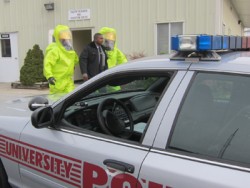UMES conducted a full-scale exercise to help the school better prepare for an actual emergency and comply with recent updates to the Clery Act. UMES recommends a “crawl, walk, run” approach to testing the university’s emergency response plans, with the full-scale exercise representing the “run” phase. The in-depth video examines the benefits and considerations when conducting a full-scale exercise of an emergency on campus.
"It's an example of a carefully planned Hazardous Material (HAZMAT) Exercise conducted on a college campus," explained Kenneth A. Collins, Interim Chief of Police at University of Maryland Eastern Shore. "It was a classic exercise utilizing the National Incident Management System (NIMS) and Incident Command System (ICS) protocol as mandated by Maryland State Government and Federal Government as well."
"The exercise was an eye opening experience for all agencies involved. While the introduction to the concept (crawl phase) and Table Top Exercise (walk phase) is important, it is the hands-on experience (run phase) that is key in preparing for a real life emergency – learning and using a multi-agency approach to accomplish the objective. It’s about testing the actual response capability for both on-campus assets and local supporting first responders directed toward minimizing the effects of an emergency situation. The University of Maryland Eastern Shore Department of Public Safety is proud and honored to have worked with Omnilert to make the video a complete success."
S. Daniel Carter, the Director of 32 National Campus Safety Initiative, said, "This video clearly explains both the importance of and how to conduct a full scale exercise. They have managed to take something many institutions find intimidating and make it seem both essential and feasible."
Updated in 2008 with enforcement stepped up in recent years, Congress amended the Jeanne Clery Act of 1990 to require colleges and universities to adopt and disclose summaries of emergency response plans and evacuation plans. Furthermore, institutions must conduct an annual test, defined as regularly scheduled drills, exercises, and appropriate follow-through activities, designed for assessment and evaluation of emergency plans and capabilities. A drill is an activity that tests a single procedural operation, such as testing the emergency notification system. An exercise is a test involving coordination of efforts, which can range from a tabletop exercise to a full-scale exercise.

